Yamaha YZF-R1
The Yamaha YZF-R1, or R1, is an open class sport bike, or superbike, motorcycle made by Yamaha from 1998 through the current 2020 model year.[2]
| Manufacturer | Yamaha Motor Company |
|---|---|
| Also called | Yamaha R1 |
| Production | 1998–2020 |
| Predecessor | Yamaha YZF1000R |
| Class | Sport bike[1] |
| Related | Yamaha YZF-R6 Yamaha MT-10 |
1998–1999
Yamaha launched the YZF-R1 after redesigning the Genesis engine to create a more compact engine by raising the gearbox input shaft and allowing the gearbox output shaft to be placed beneath it. This 'stacked gearbox' was followed by other manufacturers. Compacting the engine made the engine much shorter, allowing the wheelbase to be shortened. This allowed the frame design to place the weight of the engine in the frame to aid handling because of an optimized center of gravity. The swingarm could be made longer without compromising the overall wheelbase, which was a short 1,385 mm (54.5 in). Four 40 mm Keihin CV carburetors fed fuel to the engine. It had KYB upside down 41 mm front forks and 300 mm semi-floating disk brakes. The instrument panel was electrical with a self diagnosis system and digital speed readout. The exhaust system used Yamaha's Exhaust Ultimate Power Valve (EXUP), which controlled the exhaust gas flow to maximize engine power production at all revs. This created a high powered and high torque engine. The Yamaha YZF-R6 was introduced in 1999 as the 600 cc version of the R1 super bike.
The 1999 R1 saw only minor changes, apart from paint and graphics. More improvements were a redesigned gear change linkage and the gear change shaft length being increased. Fuel tank reserve capacity was reduced from 5.5 to 4.0 L (1.21 to 0.88 imp gal; 1.5 to 1.1 US gal), while the total fuel tank capacity was unchanged at 18 l (4.0 imp gal; 4.8 US gal).
Motorcycle Consumer News tests of the 1998 model year YZF-R1 yielded a 0 to 60 mph (0 to 97 km/h) time of 2.96 seconds and 0 to 100 mph (0 to 161 km/h) of 5.93 seconds, a0 to 1⁄4 mi (0.00 to 0.40 km) time of 10.19 seconds at 131.40 mph (211.47 km/h), and a top speed of 168 mph (270 km/h), with deceleration from 60 to 0 mph (97 to 0 km/h) of 113.9 ft (34.7 m).[1] For the 1999 model year, Cycle World tests recorded a 0 to 60 mph (0 to 97 km/h) time of 3.0 seconds, 0 to 1⁄4 mi (0.00 to 0.40 km) time of 10.31 seconds at 139.55 mph (224.58 km/h), and a top speed of 170 mph (270 km/h).[3]
2000–2001
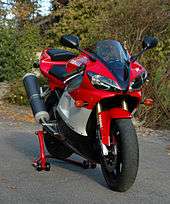
In 2000, Yamaha introduced a series of changes to improve the bike, and minor changes to the bodywork to allow for better long duration ride handling. Yamaha's main design goal was to sharpen the pre-existing bike and not to redesign it. The dry weight was reduced five pounds to 414 lb (188 kg).[4]
At 127.8 hp (95.3 kW) at the rear wheel,[4] top-end output remained the same, but changes to the engine management system were intended to result in a smoother, broader distribution of power. The bodywork was still unmistakably R1, although a few changes were made resulting in a 3% reduction in the drag coefficient. The headlight housing's profile was sharpened, the side panels were made more aerodynamic and slippery, and the windscreen was reshaped for better rider protection.
The seating area was also updated. The fuel tank was reshaped, with a more relaxed rear angle and deeper leg recesses to provide for a better rider feel. The seat extended further towards the rear of the tank and the new, steeper, seating position put additional weight on the front end. All of this was aimed at improving weight bias and offering sharper cornering and more stability.
Mechanically, the carburetors were re-jetted in an effort to improve throttle response, especially in the low end, all the way up to the bike's 11,750 rpm redline. The redesigned camshafts were lightened and used internal oil ways to lubricate journals that, when combined with reduced tappet clearance, provided less friction and created less engine noise. The gearbox received a taller first gear, a hollow chrome moly shift shaft with an additional bearing and a completely redesigned shift linkage and foot pedal. These changes were aimed at eliminating problems with the transmission in earlier models, and to help to seamlessly transfer the bike's power to the road.
2002–2003

A new fuel injection system was introduced for the 2002 year, which worked like a carburetor by employing a CV carburetor slide controlled by vacuum created by the engine. With a similar power output to the 2000-2001 bike, the engine remained largely the same. One notable improvement was the use of new cylinder sleeves of a high silicon content alloy containing magnesium that minimized heat induced distortion, reducing oil consumption. Also in 2002, Yamaha released the newly developed Deltabox frame,[5] which, with its hydro formed construction, reduced the total number of frame welds. These changes improved the frame's rigidity by 30%. The cooling system was redesigned for better performance and compactness. The exhaust system was changed from a 4-into-1 to a new titanium 4-into-2-into-1 design. The rear end of the motorcycle was updated and streamlined with a LED taillight. This allowed for very clean rear body lines when choosing one of several common after market modifications, such as removal of the turn signal stalks and stock license plate bracket; and replacing them with assorted available replacements that "hug" the body or frame. Also, front end lighting was improved in 2002, between the higher definition headlights and also side "parking" lights within the twin-headlight panel, giving a more angular appearance. This also gave additional after market possibilities, such as to remove the front turn signals and use these front lights as directional or hazard markers while stopped. For 2003, the only change was fitted hazard warning lights and dipped headlights, which stay on all the time the engine is running.
In 2002, Cycle World reported fuel mileage of 38 mpg‑US (6.2 L/100 km; 46 mpg‑imp), a 0 to 60 mph (0 to 97 km/h) time of 2.9 seconds, a 0 to 1⁄4 mi (0.00 to 0.40 km) time of 10.32 seconds at 137.60 mph (221.45 km/h), and a top speed of 167 mph (269 km/h).[6]
2004–2005

With the competition advancing, Yamaha made some major changes to the model. This included style updates, like an under seat twin exhaust, and performance upgrades including radial brakes, and, for the first time an R1 Ram-air intake. Furthermore, the tendency for wheelies by earlier productions was reduced by changing the geometry of the frame and weight distribution. The all-new engine was no longer used as a stressed member of the chassis, and had a separate top crankcase and cylinder block.
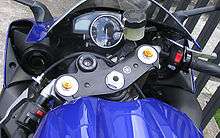
The 2004 R1 weighs 172 kg (379 lb) dry. The conventional front brake calipers were replaced by radially mounted calipers, activated by a radial master cylinder. A factory-installed steering damper was also added this year. Combined with the changes to the frame, this helped to eliminate the tendency of the handlebars to shake violently during rapid acceleration or deceleration on less-than-perfect surfaces, a phenomenon known as a speed wobble or tank slapper.
Motorcycle Consumer News tests of the 2004 model year YZF-R1S yielded a 0 to 60 mph (0 to 97 km/h) time of 3.04 seconds and 0 to 100 mph (0 to 161 km/h) of 5.42 seconds, a quarter-mile time of 9.90 seconds at 144.98 mph (233.32 km/h), and a top speed of 179 mph (288 km/h).[1]
John McGuinness won the senior race at the 2005 Isle of Man TT.
2006
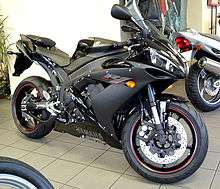
The swingarm was extended by 20 mm (0.79 in) to reduce acceleration instability. In this year, Yamaha also released a limited edition version in original Yamaha racing colors to celebrate its 50th anniversary. The model (LE/SP) had a Kenny Roberts front and rear custom Öhlins suspension units developed by the same team as the YZR-M1 MotoGP bike. Custom forged aluminum Marchesini wheels specifically designed for the LE shaved nearly a pound off the unsprung weight. A back torque-limiting slipper clutch, and an integrated lap timer rounded out the package, making the LE virtually a production racer. Only 500 units were made for the United States with another 500 units for Europe.
2007–2008
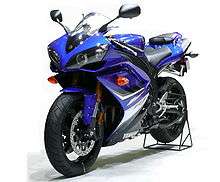
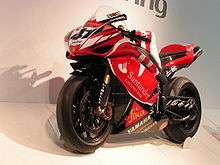
An all-new YZF-R1 for the 2007 model year was announced on 8 October 2006. It had an all-new inline four-cylinder engine, going back to a more conventional four-valves per cylinder, rather than Yamaha's trade mark five-valve Genesis layout. It also had the Yamaha Chip Control Intake (YCC-I) electronic variable-length intake funnel system, Yamaha Chip Control Throttle (YCC-T) fly-by-wire throttle system, slipper-type clutch, all-new aluminum Deltabox frame and swingarm, six-piston radial-mount front brake calipers with 310 mm discs, a wider radiator, and M1 styling on the new large ram-air ports in the front fairing. There were no major changes for 2008. Power at the rear wheel was 156.7 hp (116.9 kW) @ 10,160 rpm.[7]
Motorcycle Consumer News tests of the 2007 model year YZF-R1 yielded a 0 to 60 mph (0 to 97 km/h) time of 2.94 seconds and 0 to 100 mph (0 to 161 km/h) of 5.46 seconds, a ¼ mile time of 9.88 seconds at 145.50 mph (234.16 km/h).[1]
2009–2014
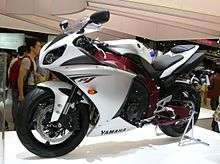
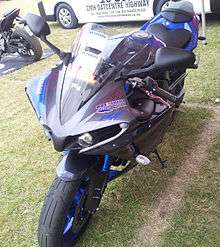
In late 2008, Yamaha announced they would release an all new R1 for 2009. The new R1 takes engine technology from the M1 MotoGP bike with its cross plane crankshaft. Crossplane technology puts each connecting rod 90° from the next, with an uneven firing interval of 270°- 180°- 90°- 180°. The 2009 R1 was the first production sportbike to use a crossplane crankshaft.[8] The power delivery is the same as a 90° V4 with a 180° crank, such as the Honda VFR800 and very similar to the Yamaha V-Max which has been lauded for its exhaust sound.[9] Yamaha claims the bike would give the rider 'two engines in one', the low end torque of a twin and the pace of an inline four. As with previous incarnations of the R1, the 2009 model keeps its Yamaha Chip Controlled Throttle (YCC-T).
Another advancement included on the 2009 model was D-Mode Throttle Control Valve Mapping, which allows a rider to choose between three distinct maps depending on the rider's environment. Each mode of operation controls YCC-T characteristics, changing how the R1 reacts to rider input. The first mode is Standard Mode, which delivers performance for a wide variety of driving conditions. The second mode is "A" mode which will give a rider more available power in the lower to mid RPM range. The third mode is "B" mode, which is a dial back of the previous mode, designed to soften throttle response in inclement weather and heavy traffic. D-Mode throttle control is controlled by the rider through a forward mode button near the throttle. The instrument panel is more comprehensive than previous models, and the 2009/2010 Yamaha YZF-R1 model had a gear indicator as standard.
Overall handling of the R1 was improved through changes to frame and suspension. A new sub frame was designed for the 2009 R1, cast from magnesium giving lower weight aiding mass centralisation. The rear shock absorber on the 2009 offers variable speed damping, as well as an easy to tweak pre-load via a screw adjustment. The rear shock now connects underneath the swing arm through a different linkage; a change from previous years' models. To improve overall handling and safety, Yamaha included an electronic steering damper.
The front has the same classic R1 shape, though the air intake location and headlamp design have been revamped on the 2009 model; using only projector lamps, and using the new-found design space within the nose cone to reroute ram air tubes next to the lights.
Testing the 2010 model year in the confines of a tri-oval racetrack, Motorcyclist magazine reported a 0 to 1⁄4 mi (0.00 to 0.40 km) time of 10.02 seconds @ 144.23 mph (232.12 km/h), and fuel consumption of 25 mpg‑US (9.4 L/100 km; 30 mpg‑imp).[10] Motorcycle Consumer News reported a tested top speed of 176.7 mph (284.4 km/h).[1]
In 2012 the Yamaha YZF-R1 received traction control, redesigned upper cowl (nose of bike), and a special edition 50th Anniversary R1 was released. The special edition color is inspired from Assen TT-winning MotoGP bike. The special edition commemorates the participation of Yamaha in MotoGP. Only 2000 units of this edition were made.
2015–2020
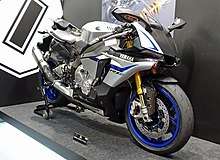
At the centennial EICMA motorcycle show, Yamaha officially unveiled a new generation of R1.[11] It is similar to MotoGP's 2005–Present YZR M1. Yamaha claims a wet weight of 199 kg (439 lb)[12] The new bike has an electronics package that includes a sophisticated Traction Control (TCS) and Slide Control System (SCS), antiwheelie Lift Control System (LIF), linked antilock brakes, Launch Control System (LCS), Quick Shift System (QSS), and selectable power modes. The Slide Control System on the Yamaha YZF-R1 is the first on a production motorcycle.[13][14] Information is fed to the bike through a six-axis gyro (Inertial measurement unit) and other sensors over 100 times a second.[14] Power delivery is tapered through manipulation of the throttle butterfly and ignition and fuel cuts.[15] Engine changes include shortened bore-to-stroke ratio, larger airbox, a finger-follower valve system, and fracture split titanium conrods.[13] It comes standard with magnesium wheels. Information is presented to the rider through a user-customizable thin-film display.[13]
A second higher-spec, limited production model is also produced called the R1M, and is differentiated from the standard model by having more expensive components such as electronic semi-active Öhlins suspension, carbon fiber bodywork, Yamaha's Communication Control Unit (CCU), Y-TRAC data logging system, and stickier Bridgestone tires with larger rear 200/55-size. A third model starting in 2016 is also offered a lower-spec R1S.[16][17]
Specifications
| Year | 1998 - 1999[3][18] | 2000–2001[19][20] | 2002 - 2003[6][21] | 2004–2005 | 2006 | 2006 LE | 2007[22]-2008 | 2009[10] | 2010[23] | 2012-2014[24] | 2015–2020[25] |
|---|---|---|---|---|---|---|---|---|---|---|---|
| Engine | |||||||||||
| Type | 998 cc (60.9 cu in), liquid-cooled, 20-valve, DOHC, inline four-cylinder | 998 cc, liquid-cooled, 16-valve, DOHC, inline four-cylinder | 998 cc, liquid-cooled, 16-valve (titanium), DOHC, in-line four-cylinder, cross-plane crankshaft | ||||||||
| Bore × stroke | 74 mm × 58 mm (2.9 in × 2.3 in) | 77 mm × 53.6 mm (3.03 in × 2.11 in) | 78 mm × 52.2 mm (3.07 in × 2.06 in) | 79.0 mm x 50.9 mm | |||||||
| Fuel system | Carburetor | Mikuni BDSR40 carburetors with TPS | Mikuni fuel injection | Fuel injection, motor-driven secondary throttle valves | Fuel injection, dual-valve throttle bodies with motor-driven secondary valves | Fuel Injection with YCC-T and YCC-I | |||||
| Compression ratio | 11.8:1 | 12.5:1 | 12.7:1 | 12.3 : 1 | 13.0 : 1 | ||||||
| Rev limiter | 13,750 rpm | ||||||||||
| Manufacturer rated horsepower (crank) | 150 hp (110 kW)[26] | 150.0 hp (111.9 kW) @ 10,000 rpm | 152.0 hp (113.3 kW) @ 10,500 rpm | 172 hp (128 kW), 180 hp (130 kW) with ram air[27][28] | 132.4 kW (177.6 hp) @ 12,500 rpm / 139.0 kW (186.4 hp) @ 12,500 rpm with ram air [29] | 191 hp (142 kW) @ 12,500 rpm without ram air [30] | 199 hp (148 kW)[15] 200.0 hp (149.1 kW)(with track only Circuit ECU)[15] | ||||
| Rear wheel horsepower | 129.4 hp (96.5 kW),[1] 129.3 hp (96.4 kW) @ 10,550 rpm[3] | 130 hp (97 kW)[20] | 127.2 hp (94.9 kW),[1] 134.1 hp (100.0 kW) @10,800 rpm[6] | 152.9 hp (114.0 kW) @ 10,160 rpm,[7] 156.7 hp (116.9 kW)[1] | 180.7 hp (134.7 kW)[1] | 188.4 hp (140.5 kW)@ 12,720 rpm[31] | |||||
| Torque | 72.7 lb⋅ft (98.6 N⋅m),[1] 72.0 lb⋅ft (97.6 N⋅m) @ 8,250 rpm[3] | 70.4 lb⋅ft (95.4 N⋅m)[1] | 106.6 N⋅m (78.6 lbf⋅ft) @ 10,500 rpm (claimed) [28] | 75.5 lb⋅ft (102.4 N⋅m),[1] 73.6 lb⋅ft (99.8 N⋅m) @ 8,150 rpm[6] | 76.2 lb⋅ft (103.3 N⋅m)[10] | 78.6 lb⋅ft (106.6 N⋅m),@ 8,790 rpm [31] (rear wheel) | |||||
| Final drive | #530 O-ring chain | 525 O-ring chain | |||||||||
| Ignition | TCI | ||||||||||
| Transmission | 6-speed w/multi-plate clutch | 6-speed w/multi-plate slipper clutch | 6-speed w/multi-plate coil spring slipper clutch | ||||||||
| Chassis | |||||||||||
| Brakes/Front | Dual 298 mm discs | Dual 320 mm discs, radial-mount forged 4-piston calipers | Dual 310 mm discs, radial-mount forged 6-piston calipers | Hydraulic dual disc, Ø 320 mm | |||||||
| Brakes/Rear | Single Piston (Pin Sliding) Caliper w/ 240 mm disc | Single Piston (Pin Sliding) Caliper w/ 220 mm disc | |||||||||
| Suspension/Front | 41 mm inverted telescopic fork | 43 mm inverted telescopic fork, 120 mm (4.7 in) travel | |||||||||
| Suspension/Rear | Single shock, adj. preload, compression damping, rebound damping, 130 mm (5.1 in) travel | Single shock, 130 mm (5.1 in) travel | Single shock, adj. preload, compression damping, rebound damping, 130 mm (5.1 in) travel | Single Öhlins shock, adj. preload, adj. high-/low-speed compression damping, rebound damping, 130 mm (5.1 in) travel | Single shock, piggyback reservoir, spring preload, adj. high-/low-speed compression damping, rebound damping | Swingarm, 120 mm travel | (link suspension), Monoshock, 120 mm travel | Swingarm, (link suspension), 120 mm travel | |||
| Tires/Front | 120/70-ZR17 | ||||||||||
| Tires/Rear | 190/50-ZR17 | 190/55-ZR17 | |||||||||
| Dimensions | |||||||||||
| Length | 2,035 mm (80.1 in) | 2,065 mm (81.3 in) | 2,090 mm (82.1 in) | 2,060 mm (81.1 in) | 2,070 mm (81.5 in) | 2,070 mm (81 in) | 2,055 mm (80.9 in) | ||||
| Width | 695 mm (27.4 in) | 720 mm (28 in) | 720 mm (28.3 in) | 710 mm (28.1 in) | 715 mm (28.1 in) | 690 mm (27 in) | |||||
| Height | 1,095 mm (43.1 in) | 1,105 mm (43.5 in) | 1,100 mm (43.5 in) | 1,110 mm (43.7 in) | 1,130 mm (44.5 in) | 1,130 mm (44 in) | 1,150 mm (45 in) | ||||
| Seat height | 800 mm (31 in) | 815 mm (32.1 in) | 818 mm (32.2 in) | 815 mm (32.1 in) | 835 mm (32.9 in) | 830 mm (32.8 in) | 835 mm (32.9 in) | 855 mm (33.7 in) | |||
| Wheelbase | 1,415 mm (55.7 in) (1,394 mm (54.9 in) claimed)[18][26] | 1,395 mm (54.9 in) | 1,415 mm (55.7 in) | ||||||||
| Rake | 24.0° | ||||||||||
| Trail | 92 mm (3.6 in) | 103 mm (4.1 in) | 97 mm (3.8 in) | 100 mm (4.0 in) | 102 mm (4.0 in) | 102 mm (4.0 in) | |||||
| Fuel capacity | 18 l (4.0 imp gal; 4.8 US gal) | 17 l (3.7 imp gal; 4.5 US gal) | 18 l (4.0 imp gal; 4.8 US gal) | 18 l (4.0 imp gal; 4.8 US gal) | 17 l (3.7 imp gal; 4.5 US gal) | ||||||
| Dry weight | 190.1 kg (419 lb)[3] | 187.8 kg (414 lb)[20] | 187 kg (412 lb)[6] | 172.0 kg (379.2 lb) | 172.8 kg (381 lb) | 173.7 kg (383 lb) | 177 kg (390 lb)[29] | 177 kg (390 lb),[32] 203.2 kg (448 lb)[10] | |||
| Wet weight* | 198.2 kg (437 lb) (claimed)[26] | 200.9 kg (443 lb)[20] | 193 kg (425 lb), 194 kg (428 lb) (Cali)[33] | 206 kg (454 lb) (claimed),[30] 216.4 kg (477 lb)[10] | 206 kg | 199 kg (439 lb) [12] | |||||
| Performance | |||||||||||
| Top speed | 270 km/h (168 mph)[1] | 278 km/h (173 mph)[1] | 288 km/h (179 mph)[1] | 293 km/h (182 mph)[1] | |||||||
| 0 to 97 km/h (0 to 60 mph) | 2.96[1] sec. | 2.99[1] sec. | 3.04[1] sec. | 2.64[1] sec. | |||||||
| 0 to 161 km/h (0 to 100 mph) | 5.93[1] sec. | 5.79[1] sec. | 5.42[1] sec. | 5.12[1] sec. | |||||||
| 0 to 1⁄4 mi (0.00 to 0.40 km) | 10.19[1] sec. | 10.17[1] sec. | 9.90[1] sec. | 9.88[1] sec. | 10.05[1] sec. | 10.31 @ 148.12 [34] 10.11 sec. @ 146.62 mph [31] 9.83 sec. @ 149.91 mph [35] | |||||
| Braking 97 to 0 km/h (60 to 0 mph) | 34.7 m (113.9 ft)[1] | 35.1 m (115.3 ft)[1] | 35.8 m (117.3 ft)[1] | 35.9 m (117.9 ft)[1] | 37.8 m (124.0 ft)[1] | 38.4 m (126.0 ft)[31] | |||||
| Fuel consumption | 5.50 L/100 km; 51.4 mpg‑imp (42.8 mpg‑US)[1] | 5.67 L/100 km; 49.8 mpg‑imp (41.5 mpg‑US)[1] | 5.65 L/100 km; 50.0 mpg‑imp (41.6 mpg‑US)[1] | 6.53 L/100 km; 43.2 mpg‑imp (36.0 mpg‑US)[1] | 8.0 L/100 km; 35.3 mpg‑imp (29.4 mpg‑US)[1] | ||||||
- Includes oil and full fuel tank.
Motorsport
The bike had five wins in the Macau Grand Prix between 1999 and 2013. Lorenzo Alfonsi won the 2004 FIM Superstock 1000 Cup, followed by Didier Van Keymeulen in 2005.[36] Yamaha World Superbike riders Troy Corser and Noriyuki Haga finished 2nd and 3rd respectively in the 2008 Superbike World Championship season.[36] Yamaha World Superbike rider Ben Spies won the 2009 Superbike World Championship season title recording 14 wins and 11 poles in his one season in WSBK.[36] The Yamaha Factory Racing Team with riders N. Nakasuga, P. Espargaro, and B. Smith won the 2015 Suzuka 8 Hours endurance race.[37] Katsuyuki Nakasuga, Alex Lowes, Pol Espargaro won the 2016 Suzuka 8 Hours endurance Race. Tommy Hill won the British Superbike title in 2011 on board a YZF-R1. Yamaha rider Josh Brookes won the 2015 British Superbike series title.[38]
References
- "Performance Index - Winter '11/'12 Edition" (PDF), Motorcycle Consumer News, Bowtie Magazines, January 2012, retrieved May 31, 2012
-
- "Performance Index - Winter '11/'12 Edition" (PDF), Motorcycle Consumer News, Bowtie Magazines, January 2012, retrieved May 31, 2012
- Cernicky, Mark (September 2008), "Master Bike XI", Cycle World, Newport Beach, California: Hachette Filipacchi Media U.S., vol. 47 no. 8, ISSN 0011-4286
- Brown, Roland (2005), The ultimate history of fast motorcycles, Bath, England: Parragon, pp. 215, 258, ISBN 1-4054-5466-0
- Walker, Mick (2001), "Superbikes", Performance Motorcycles, Amber Books, Ltd. and Chartwell Books (Book Sales, Inc.), pp. 26–57, ISBN 0-7858-1380-2
- Catterson, Brian (May 1999), "YZF-R1", Cycle World, Newport Beach, California: Hachette Filipacchi Media U.S., vol. 38 no. 5, pp. 47–50, ISSN 0011-4286
- "Sport Rider: Yamaha Weights and Measurements", Sport Rider, 2009, archived from the original on March 12, 2009
- Mayhersohn, Norman (November 1987), "Yamaha FZR", Popular Mechanics, p. 48
- Canet, Don (June 2002), "Show of Force; Turn and burn aboard the Sport Fours", Cycle World, Newport Beach, California: Hachette Filipacchi Media U.S., vol. 41 no. 6, pp. 46–50, ISSN 0011-4286
- Cernicky, Mark (September 2008), "Master Bike XI", Cycle World, Newport Beach, California: Hachette Filipacchi Media U.S., vol. 47 no. 8, ISSN 0011-4286
- 2009 Yamaha YZF-R1 Features Uneven Firing Order For Improved Power Delivery, Yamaha press release via Road Racing World, 2008, retrieved 2009-05-23
- 2009 Star V-Max Review/Test, Motorcycle.com, August 26, 2008, archived from the original on 1 May 2010, retrieved 2010-04-20
- Henning, Ari (April 2010), "Liter-bike outliers: different for a reason.(MC Comparison Aprilia RSV4R VS. Yamaha YZF-R1)", Motorcyclist, pp. 62–68, retrieved 2011-04-26
- "Home - Eicma". eicma.it.
- "2018 Yamaha YZF-R1 Supersport Motorcycle - Photo Gallery, Video, Specs, Features, Offers, Inventory and more". www.yamahamotorsports.com.
- Conner, Blake (June 22, 2015). "2015 Yamaha YZF-R1 - ROAD TEST". Cycle World. Retrieved February 4, 2017.
- Klein, Max (July 20, 2015). "2015 Yamaha YZF-R1: MD Ride Review". Retrieved February 4, 2017.
- Conner, Blake (February 21, 2015). "2015 Yamaha YZF-R1/R1M - First Ride". Cycle World. Retrieved February 4, 2017.
- Canet, Don (July 1, 2016). "2016 Yamaha YZF-R1M vs. YZF-R1S - COMPARISON TEST". Cycle World. Retrieved February 4, 2017.
- Adams, Bradley (February 26, 2015). "2015 Yamaha YZF-R1M First Ride Review". Sport Rider. Retrieved February 4, 2017.
- Canet, Don (February 1998), "Rippin' Ride", Cycle World, Newport Beach, California: Hachette Filipacchi Media U.S., vol. 37 no. 2, pp. 32–36, ISSN 0011-4286
- 2000 YZF-R1 specifications from Yamaha Motors
- "Superbikes 2000!", Motorcyclist, pp. 41–62, July 2000
- 2002 YZF-R1 specifications from Yamaha Motors
- 2007 YZF-R1 specifications from Yamaha Motors
- "[title] Motor". yamaha-motor.eu. Retrieved 2016-03-25.
- UK, Yamaha Motor. "[title]". yamaha-motor.eu. Retrieved 2016-03-25.
- UK, Yamaha Motor. "[title]". yamaha-motor.eu. Retrieved 2016-03-25.
- Anderson, Steve (December 1997), "YZF R1; Something wicked this way comes", Cycle World, Newport Beach, California: Hachette Filipacchi Media U.S., vol. 36 no. 12, pp. 34–39, ISSN 0011-4286
- Tech. Spec--2004-YZF-R1 from Yamaha Motor Europe
- "Specs; Yamaha YZF-R1", The Sunday Times, Perth, Western Australia, p. R.76, 11 September 2005
- Tech. Spec--2007-YZF-R1 from Yamaha Motor Europe
- 2009 Yamaha YZF-R1 from Yamaha Motor Europe
- Adams, Bradley (July 19, 2016). "Aprilia RSV4 RR vs. Ducati 959 Panigale vs. Kawasaki ZX-10R vs. Yamaha YZF-R1 - COMPARISON TEST". Cycle World. Retrieved July 20, 2016.
- "2009 Yamaha R1 Reportedly Heavier and Less Powerful than the 2007 R1 - Asphalt & Rubber". asphaltandrubber.com. 15 April 2009.
- 2002 Yamaha YZF-R1 Service Manual
- "Sportbike Performance Numbers". Sport Rider. February 25, 2014. Retrieved 2016-09-05.
- Canet, Don (June 24, 2015), "Comparison: Yamaha YZF-R1 By The Numbers", Cycle World
- "WorldSBK". www.worldsbk.com.
- http://www.fimewc.com/wp-content/uploads/2015/07/Offcial-Race-Results1.pdf
- "2018 Bennetts British Superbike Championship in association with Pirelli". www.britishsuperbike.com.